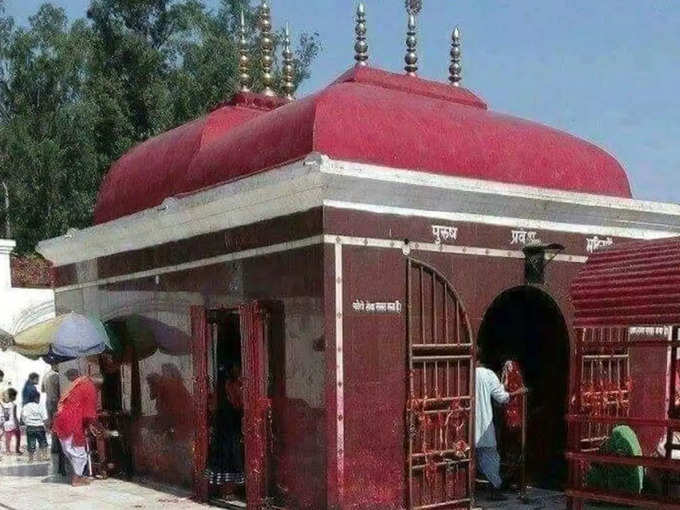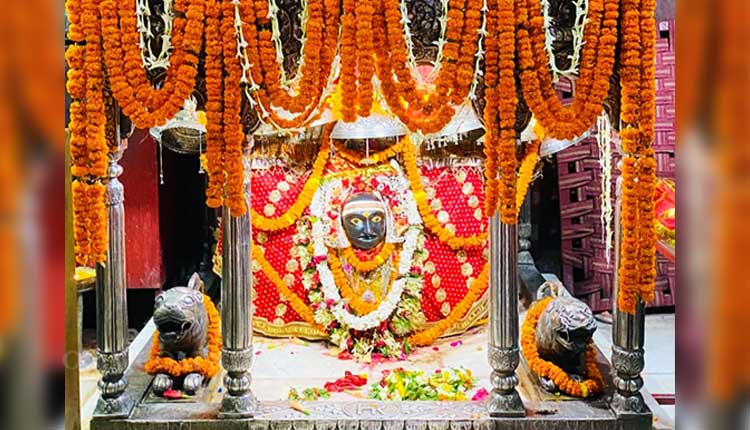Thawe Mandir, the Temple of Maa Thawewali in Thawe, in Gopalganj District in the State of Bihar

Thawe Mandir, also known as the Temple of Maa Thawewali, is a sacred place situated in Thawe village, Gopalganj District, Bihar, India. It is located just 6 km away from Gopalganj town along the Gopalganj-Siwan National Highway.
Thawe village is found in the southwest direction, about 6 km from the district headquarters. It is home to the Thawe junction station, which connects the northeastern railway’s Masrakh-Thawe section with the Siwan-Gorakhpur loop-line. In the village, there is an ancient fort with an intriguing history, although the details are not well-documented. The palace of the King of Hathwa once stood there, but it is now in a dilapidated state. Adjacent to the residence of the Hathwa Raja is an old temple dedicated to Goddess Durga. Inside the temple complex, there is a unique tree whose botanical family remains unidentified. The tree has grown in a cross-like shape, giving rise to various legends associated with the idol and the tree. Every year, a grand fair takes place in the month of Chaitra (March-April) to commemorate the occasion.
The Thawe Mandir is overseen by a trust comprising esteemed members, including:
- Shri Sunil Kumar: Deputy Inspector General of Police, Saran (Chapra)
- Circle Officer Gopaljanj
- Shri Kautubhmadi Shahi
- Shri Daroga Singh
- Shri Pradeep Kumar Dash
- Shri Rudal Prashad
- Dr. Shashi Shekhar Singh
- Shri Gopichand Yadav
- Shri Omprakash Rai
- Shri Sudhama Manjhi
- Shri Jitendra Yadav
These individuals play an important role in the management and administration of the Thawe Mandir, ensuring the smooth functioning of the temple and its associated activities.
Mandir Open and Arti Timing
Maa Aarti Timming: Morning 5 Am Evening 8 Pm
Mata ka Bhog Rag: 12:30 After Noon
Mandir Open Timming: Morning 4 Am to Evening 9 Pm
Rest Time: 12:30 to 2:30 In Noon
Raja Suhag Mandir, Thawe Gopal Ganj, Bihar. Photos, How and Where, Story
The story of devotee Rahashu is associated with the renowned Thawe Mandir in Gopalganj, Bihar.
Thawe Durga Mandir in Gopalganj district of Bihar is believed to fulfill the sincere prayers and devotion of worshippers and devotees. The temple is surrounded by forests from two sides and has an ancient sanctum sanctorum. Devotees from various districts of Nepal, Uttar Pradesh, and Bihar come here for worship and darshan. Although devotees visit throughout the year, the worship during the months of Chaitra and Sharadiya Navratri holds special significance. A grand fair is organized during Navratri. Additionally, special worship is conducted on Mondays and Fridays in this temple.
Special worship and rituals are also performed during the month of Sawan. This temple is also known as Thawe Wali Mata Mandir or Singhasini Bhavani Mandir. It has a tradition of offering animal sacrifices during Navratri. Devotees come to the Mother’s court empty-handed but receive the blessings that fulfill their desires. Thawe Durga Mandir is considered a Siddh Peeth.
The story behind the establishment of Thawe Durga Mandir is quite fascinating. King Manan Singh of the Chero dynasty considered himself a devoted follower of Goddess Durga. During his reign, there was a sudden famine in his kingdom. During that time, there was a devotee named Rahashu in Thawe who miraculously extracted rice by pulling a plate towards him after placing it in front of a tiger. This led to the availability of food for the people. When the news reached the king, he did not believe it. The king opposed Rahashu and asked him to bring the Goddess to the kingdom. Rahashu warned the king that if the Goddess came, she would destroy the kingdom, but the king did not believe him. Upon Rahashu’s insistence, Goddess Kamakhya arrived from Patna and Saran, wreaking havoc on the king’s palaces. After this, the king passed away.
According to another legend, Raja Yuvraj Shahi Bahadur of Hathua established the Thawe Durga Mandir in the year 1714. During his return from a battle with Kabul Mohammed Badharia, the Chhapra landlord, he took rest under a huge tree in the Thawe forest. In a dream, Goddess Durga appeared to him and showed him the victory he would achieve by attacking Kabul Mohammed Badharia. He conquered and captured Kalyanpur, Husseypur, Selari, Bhelari, Turkaha, and Bhurkaha under his kingdom. After the victory, the king dug at a spot four steps north of the tree, where he found a ten-foot-deep idol of Van Durga. That is where the temple was established.
The head priest of Thawe Durga Mandir, Suresh Pandey, and the Secretary of the Religious Trust Board, along with Gopalganj Sub-Divisional Officer Upendra Kumar Pal, mentioned that due to the new guidelines related to COVID-19, the temple is currently closed for devotees. However, the Goddess is adorned and offered food daily.
Photo Thawe Mata Mandir, Images, Pictures





